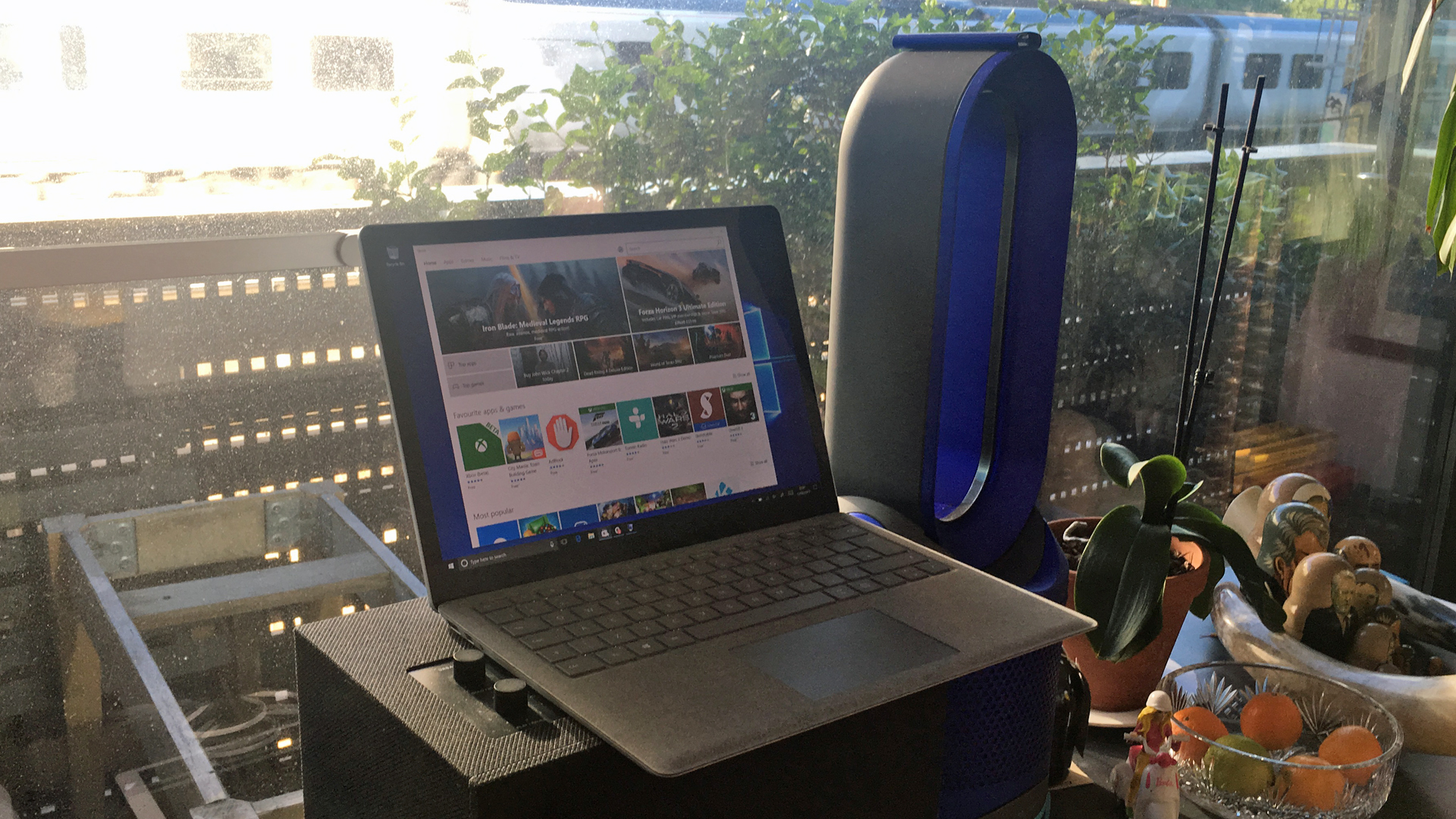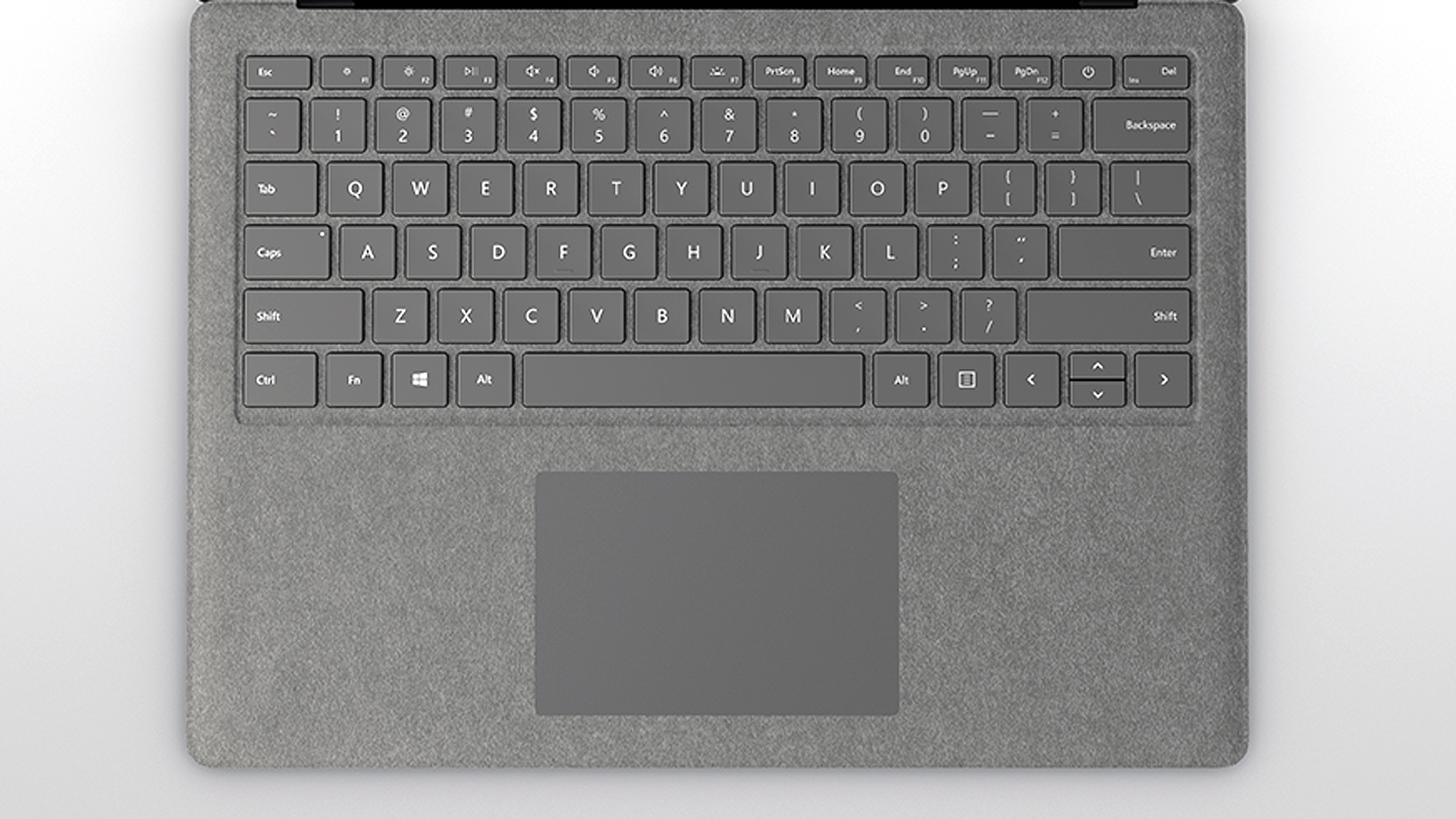Microsoft Surface Laptop review: wonderfully engineered high-end laptop with just a few baffling quirks
Slick, speedy and sexy, but why is the palm rest made of man-made fibres and what is Windows 10 S all about?


An excellent laptop whose target market is not yet entirely clear
-
+
Generally stunning design
-
+
Slick, fast operation
-
+
Excellent screen and speakers
-
-
Windows 10 S is quite limiting
-
-
Fabric palm rest seems a design flourish too far
- -
Why you can trust T3

The Microsoft Surface Laptop is an excellent laptop although, like everything Microsoft makes these days, very slightly quirky.
I've only had this laptop for about 12 hours, so consider these initial thoughts rather than a final verdict. It seems like a truly excellent product, but Windows 10 S… What is all that about?
Microsoft Surface Laptop: design
The Surface Laptop is as abstractly beautiful and malleable as its name is overly literal and slightly clunky.
It would be a bit lazy for me to say it "out-Apples Apple", but evidently I'm going to say it anyway.
That's not to suggest Microsoft has tried to ape its long-standing rival; it has produced a product of comparable quality and sex appeal to a MacBook, without the Surface Laptop seeming like a clone.
The nicely clicky keyboard has a decent amount of travel, the glass touchpad is very pleasing indeed and the touchscreen is top drawer.
On the exterior, you have a near seamless experience of aluminium, with curves tastefully and minimally deployed in just the right places. The hinge is firm enough to give confidence but it can still be flipped open with a finger.
Get all the latest news, reviews, deals and buying guides on gorgeous tech, home and active products from the T3 experts
This review sample is in 'platinum' or, as I like to call it, 'grey', but it's a very sexy grey. Those who favour a more interesting palette could also pick blue, burgundy or 'Graphite Gold' (which, to be honest, also looks kind of like grey, to me).

When open, the most distinctive feature, aside from the excellent, 301ppi, 13.5-inch, 'edge-to-edge' (well, not really, but that's what they're calling it) screen is the palm rest.
This, in line with Microsoft's long-standing Surface Book Pro line, is covered in a sort of plasticky fabric called Alcantara, which sounds more like a holiday destination, really.
There's no denying this is, again, attractive and tactile. However, my first thought on seeing it was, "Ooh, I bet that won't weather well."
Now, to be fair, on Surface Book Pros, it does seem to age reasonably well, but they are more rough and tumble devices that you might expect to develop a certain 'battered' patina.
The Surface Laptop is a gorgeous, seamless work of art, and I really don't want sweat-stains developing on it. In the current, muggy weather we're having in London, it has also begun to feel a little clammy under the palm.
Unfortunately, the only way to find out how well the Alcantara will weather is to use it for a few years. Fingers crossed.
Microsoft Surface Laptop: Windows 10 S
Funnily enough, that's also true of the operating system.
Windows 10 S is a slightly Chrome OS-style, streamlined operating system that can only use apps available at the Windows Store. There is no straightforward way around this.
Microsoft says that by having this more 'managed' experience, system bloat is avoided and the Surface Laptop never starts to slow down.
While I wouldn't question that the experience of using the OS is extremely slick, with start-up in about 15 seconds and a general and very bracing feeling of freedom from lag, I don't know it's that much better than Windows 10 Pro.
Obviously, I have no way of testing if the system remains faster for longer at this point. Get back to me in three years, again.
The down side of 10 S is obvious: there are all manner of games and apps that are very popular and widely used, that do not, as yet, work on 10 S.
I'd loved to have typed this review on the Surface Laptop rather than my geriatric MacBook Pro, but our system requires Chrome by default and Chrome (like Firefox, and any other browser you can think of) does not work.
Now, hilariously, the Surface Laptop lets you upgrade to Windows Pro for free, although it is a one-way deal. So I don't know what that tells you about Microsoft's confidence in this particular OS.
You'd think that 10 S, which is specifically targeted at the education market – would be better used on cheap, low-powered laptops rather than this, which boasts new i5 or i7 chips, an SSD and a decidedly premium price tag. It's not a deal breaker, but it is a curious choice.
Microsoft Surface Book: spec

Here's the only figures that matter (to some of you). I will say that the dimensions and weight-to-rigidity ratio, which sit in between that of a MacBook and a MacBook Pro, really do seem 'just right'.
Having had it less than one day, I haven't even bothered to charge this model (i5, 8GB, 256GB) and the battery shows no signs of running out so far.
Dimensions and Weight: 308.02 mm W, 223.2mm D, 14.47 mm thin at the back of the device and 9.93 mm thin at the front
Weight: 1.25 kg
Storage: Solid State Drive (SSD) 128/256/512GB or 1TB SSD
1 TB of OneDrive cloud storage with 1-year subscription of Office 365
Screen: 13.5-inch PixelSense Display, 2256x1504, 201 PPI, 3.4 million pixels, aspect ratio: 3:2. Corning Gorilla Glass 3.
Display Touch: 10 point multitouch Inking: Supports Surface Pen
CPU 7th Generation Intel Core i5-7200U or 7th Generation Intel Core i7-7660U
Graphics Intel CoreTM i5: HD 620 or Intel Core i7: Iris Plus Graphics 640
Memory 4GB/8GB/16GB RAM 1866Mhz LPDDR3
Connectivity: Wi-Fi a/b/g/n/ac, Bluetooth low energy 4.0, 1x full-size USB 3.0, Mini DisplayPort, headphone and microphone jacks, SurfaceConnect for magnetic power and docking
Cameras: face recognition, 720p HD video camera
Audio: OmniSonic stereo speakers with Dolby Audio Premium
Dual stereo microphones
Microsoft Surface Laptop: other fun stuff
The speakers on this are hidden beneath the keyboard and are excellent. There is, of course, not a huge amount of bass, but there is presence and a very decent sound field.
For those who like to get creative and/or touchy-feely, the Surface Laptop features, "the thinnest and lowest parallax LCD touch module on any laptop."
It's also compatible with Microsoft's stylus and if you liked that you'll be pleased to know that a new version with lower latency and four times the sensitivity is incoming shortly.
As usual with Microsoft, the main port is USB 3 rather than C.
Microsoft Surface Laptop: price
Okay, so this is where you may wince slightly. The entry level boasts an Intel i5, 128GB SSD and 4GB of RAM and costs £979.
Although that spec sounds a bit puny, realistically it is absolutely fine for most users, as long as you're happy to rely on cloud and external storage and are not planning to play Dark Souls 3 with all the graphic settings turned up – not that you can download Dark Souls 3 on Windows 10 S anyway.
After that, things get a little more testing, with pricing as follows:
256GB i5 8GB £1,249, 256GB i7 8GB £1,549, 512GB i7 16GB £2,149
As I mentioned before, Microsoft is here using the slimmed-down, sped-up version of Windows on a really quite premium laptop that could quite happily run Windows Pro.
Windows Surface Laptop: verdict
This seems like a classic 'reviewer's product' to me. By which I mean, I think it's great, but that's because I didn't have to pay for it.
The Surface Laptop is a beautiful thing, and works very well. I'm not sure the fabric palm rests and use of Windows 10 S are the greatest ideas, but mainly I think the pricing is just that bit too high.
My recommendation would be to buy the entry model, immediately upgrade it to Windows 10 Pro, then make sure you wash your hands before smearing your mucky palms all over that sumptuous Alcantara.

Duncan is the former lifestyle editor of T3 and has been writing about tech for almost 15 years. He has covered everything from smartphones to headphones, TV to AC and air fryers to the movies of James Bond and obscure anime. His current brief is everything to do with the home and kitchen, which is good because he is an excellent cook, if he says so himself. He also covers cycling and ebikes – like over-using italics, this is another passion of his. In his long and varied lifestyle-tech career he is one of the few people to have been a fitness editor despite being unfit and a cars editor for not one but two websites, despite being unable to drive. He also has about 400 vacuum cleaners, and is possibly the UK's leading expert on cordless vacuum cleaners, despite being decidedly messy. A cricket fan for over 30 years, he also recently become T3's cricket editor, writing about how to stream obscure T20 tournaments, and turning out some typically no-nonsense opinions on the world's top teams and players.
Before T3, Duncan was a music and film reviewer, worked for a magazine about gambling that employed a surprisingly large number of convicted criminals, and then a magazine called Bizarre that was essentially like a cross between Reddit and DeviantArt, before the invention of the internet. There was also a lengthy period where he essentially wrote all of T3 magazine every month for about 3 years.
A broadcaster, raconteur and public speaker, Duncan used to be on telly loads, but an unfortunate incident put a stop to that, so he now largely contents himself with telling people, "I used to be on the TV, you know."